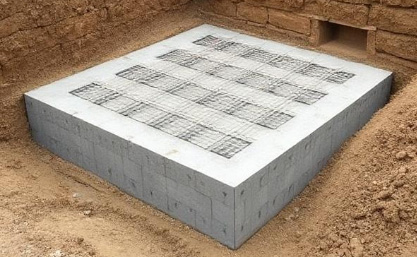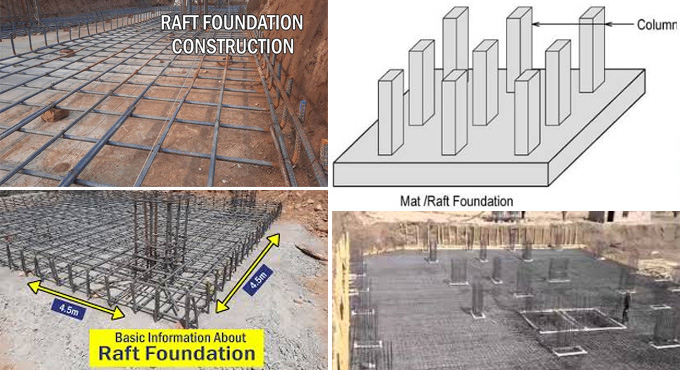
Raft Foundation: Use, Types and Construction Process

Raft foundation, also known as mat foundation, refers to the thick concrete slab which has been resting on a large ground area. The columns and walls of the building structure have been supported by the raft foundation. The raft foundation involves transferring the loads from the building structure to the ground.

In the case of the load-bearing capacity of the ground, in which the construction structure is located, is low, the raft foundation can be used. In addition, in the case of a higher chance of differential soil settlement, the raft foundation can also be used.
Materials that have been used in the raft foundation
There are different materials that have been used in the construction of the raft foundation, which are as follows:
➢ Mainly, concrete has been used in the construction of a raft foundation.
➢ The steel reinforcements have also been used to enhance the strength and durability of the raft foundation. These steel bars also help to handle the tensile stress, and this adds strength to the structure.
➢ For making the formwork of the raft foundation, wood, plastic, or metal can be used by the builders.
➢ The builders also use waterproofing membranes on the raft foundation’s surface area, which helps to prevent water ingress.
Discuss the different types of raft foundation
The raft foundation is available in different types, which are as follows:
Flat Plate Mat
The flat plate mat is the simplest form of the raft foundation, in which reinforcement has been placed in both directions of the foundation. The flat plate mat is around 300mm thick.
Two-way Beam and Slab Raft
In this type of raft foundation, the beams have been cast monolithically with the raft slab. This type of raft foundation is ideal for higher-load building structures.
Plate Thickened Under the Column
In the case of the load-bearing walls that have been subjected to heavy loads, this type of raft foundation can be used. In this context, extra reinforcement can also be required to handle the shear forces.
Piled Raft
In this type of raft foundation, piles have been combined with the raft. This piled raft can be used in weak soil conditions and provides up-and-side supports to the building structure.
Rigid Frame Mat
In this type of raft foundation, beams and slabs have been used to form a rigid grid structure, which has excellent load distribution capacity. This type of raft foundation can be used in heavy structures or in complex loads.
Plate Raft with Pedestals
Pedestals have been used in this type of raft foundation, which helps to reduce bending and shearing and provides support to the construction structure.
Effectiveness of the raft foundation in construction
➢ Raft foundations can be used in soft and marshy soils.
➢ The raft foundation helps to distribute the building’s load over a large area, which helps to reduce the overall pressure intensity that is exerted on the ground.
➢ In the case of the high water table areas, the raft foundation can also be the best choice.
➢ In the case of high-rise building structures, the raft foundation also helps to provide the required strength.
Discuss the construction details of the raft foundation
The raft foundation has been constructed in several steps, which are as follows:
Preparation of the construction site
Before starting the construction of the raft foundation, the preparation of the construction site should be done. In this context, debris present on the ground should be cleared, and the ground should be levelled properly. The ground should also be dug as per the required depth. A stable base for the foundation structure has been ensured by preparing the construction site properly.
Placement of the formwork
After preparing the construction site, formwork should be installed to contain the concrete. In this context, the formwork should be stable and strong enough to maintain the concrete’s shape.
Reinforcement placement
Once the formwork has been placed, the workers have to lay the steel bars in the formwork, which helps to provide adequate strength and support for the loads of the foundation structure.
Concrete pouring
In the next step, concrete has been poured into the formwork and spreads throughout the area. In this step, it needs to be ensured that there are no gaps or voids in the concrete.
Curing process
The concrete that has been poured into the formwork should be cured properly to achieve full strength. In this step, the concrete should be fully hydrated.
To learn more, watch the following video tutorial.
Video Source: Developing Homes
Formwork removal process
After hardening the concrete, the formwork has been removed. The final structure of the raft foundation should be examined for any defects or issues.


